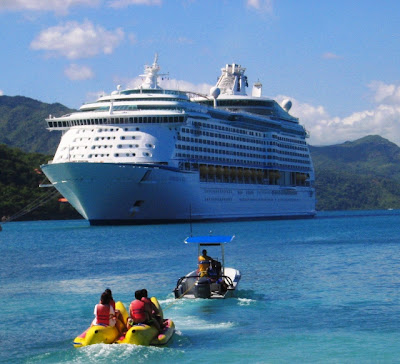How can eco-tourism help underdeveloped countries? Read this article written by Josh Lew:
Tourism might not be the ultimate answer to poverty and economic woes, but it is a major boon for places around the world that suffer from a lack of natural resources or industry. For instance, tourism is a hugely important industry in the Caribbean. Without flocks of resort-goers, nations in this part of the world would have to rely more heavily on agriculture, leaving their economies at the mercy of the fluctuating prices of commodities like coffee, sugar and bananas.
There are plenty of valid concerns about the environmental impact of hotel construction, excessive tourist traffic and cruise ships, but it isn’t fair to leave the positive economic impact out of the mass-tourism discussion. Large resorts employ hundreds of local people, and local entrepreneurs, from taxi drivers to guides to souvenir shop owners, benefit from the tourism trade.
What about eco-tourism? Is low-impact, nature-oriented travel as viable a moneymaking option as standard resort tourism?
The eco-tourism industry’s growth depends on practicality as much as it does on the will to conserve the environment. Ultimately, success will not only be measured by the acres of forest saved, but also by the amount of money earned and the number of jobs created. The International Ecotourism Society (TIES) recognizes the human element in eco-tourism. It defines the oft-catch-phrased term “eco-tourism” as “responsible travel to natural areas that conserves the environment and improves the well-being of local people.”
Many places that are considered eco-tourism destinations have experienced varying levels of success. Here are three destinations in various parts of the world that are in different stages of development, but are seeking to answer the same question: Can we make eco-tourism into one of the most important industries in our country?
Dominica
This island nation has turned to eco-tourism because it lacks the geography that makes other Caribbean destinations so popular among tourists seeking a warm-weather vacation. The postcard-like beach scenes of Jamaica and the Bahamas are absent from Dominica. The island has a rocky coast and, though its waters are clear and ideal for diving, it has never developed a mainstream resort industry. Proclaiming itself the Nature Island, Dominica has instead advertised its natural, undeveloped beauty. Hot springs and waterfalls, dense jungles and rugged coastline draw more adventurous travelers and nature lovers rather than the suntan-and-piña-colada crowd.
However, the number of visitors to Dominica is not substantial enough to make nature tourism the backbone of the nation’s economy. The capital city of Roseau has benefited from a recently built cruise ship terminal. However, Dominica remains one of the least visited nations in the eastern Caribbean. Banana cultivation is still a major source of income for many islanders. This industry can be harmed by weather (Hurricane Dean hit the island in 2007) and frequent price fluctuations on the international commodities market.
Brand-name resorts are difficult to find on Dominica. Most of the accommodations are small-scale, locally owned venues. Some are full-fledged eco-resorts built in natural settings and offer a full menu of nature-themed activities. So, despite the overall lack of tourism infrastructure, the tourists who do come to Dominica are seeing more of their dollars go to locals rather than to multinational resort chains.
A culture of conservation has been developed in Dominica. Local guides are involved in protecting one of the more popular tourist draws: nesting sea turtles. The giant amphibians lay their eggs on the seashore, with some choosing to use the sands of the beaches of the capital city. Specially trained local guides lead limited tours to the nesting areas so as not interfere with the nesting process. This type of grassroots effort is an example of the ability to balance a successful tourism attraction with a conservation effort. This culture of conservation is one of the reasons that Dominica remains such a promising eco-tourism destination.
The next steps will be important for Dominica in terms of maintaining this balance between development and conservation. An expanded airport and a cruise ship pier were necessary infrastructure upgrades. It remains to be seen if further infrastructure projects change the current relationship that Dominica has with its environment.
Botswana
This nation in southern Africa does not have to rely as heavily on tourism as Dominica and its Caribbean cousins. A relatively wealthy nation with one of the highest per capita GDP in Africa, tourism is one of the main economic alternatives to the industry that has made Botswana wealthy, diamond mining. As a landlocked country without many urban areas, nature-themed tourism is the main part of the industry by default. The backbone of this would-be tourism boom is nature-viewing safaris to places like Chobe National Park, the Okavango Delta and the vast Kalahari Desert. These uninhabited, wildlife-filled lands are considered to be among the last few untouched and truly natural places on the continent.
Botswana’s government, one of the most transparent in Africa, has adopted a string of policies over the past two decades that focus both on tourism growth and on environmental protection. These policies call for the land to be used as a resource for tourism. However, they also say that the industry must be developed in a way that doesn’t harm the environment.
To limit the number of tourists while still enjoying healthy profits, Botswana has focused on developing high-end safari tourism. Tourists pay a high premium for an all-inclusive safari that offers both comfort and easy access to the wilderness. The government can control the industry and keep out mass-market safari companies because it has strict licensing guidelines for travel companies. Would-be companies are required to complete an environmental impact report as part of their application process. There is also a national eco-tourism certification program that further encourages tourism businesses to be more eco-friendly.
These policies means that fewer people are trampling through the Okavango Delta and Chobe National Park, but money is still coming in to supplement the country’s overall GDP. This high-cost/low-volume approach might not sit well with nature enthusiasts who want to visit the pristine wilds of Botswana on a budget, but the approach has kept tourist numbers down while keeping profits at an acceptable level. Perhaps the low-volume, high-cost strategy wouldn’t work in every case, but it is an option for countries that want to develop their eco-tourism industry while not harming the environment.
Suriname
This small, unique South American nation has an ethnically diverse population and sits on the northeastern part of the continent. Most of the people here live along the Caribbean coastline. The country’s undeveloped interior is ripe for logging, but the Surinamese government, along with international conservation organizations, has decided to protect a large part of the interior from exploitation. The giant Central Suriname Nature Reserve is made up of primary forest. With the help of Conservation International, the government is trying to develop this area for tourism. Lack of infrastructure has hindered development and made it expensive to visit this area, but the reserve remains protected from logging and the government seems intent on continuing to place its bets on eco-tourism. Already operational nature preserves are found along the coastline.
A majority of the visitors to Suriname come from the Netherlands. Cultural ties from the colonial era and the fact that Dutch is still widely spoken in Suriname make this a popular alternative to the Netherlands Antilles for Dutch-speaking snowbirds. Tourism numbers are not growing quickly, and lack of infrastructure remains a major hurdle for the government’s eco-tourism plans. Still, sustainable income via eco-tourism has, for the time being, trumped immediate income from the selling of logging rights. Perhaps the example of the Central Suriname Nature Reserve could help persuade other countries with natural areas to follow a similar strategy.
Eco-tourism development is a complex issue that goes well beyond catchphrases and well-meaning attempts at conservation. Without a solid, universal model for creating a balance between a successful eco-tourism industry and a successful conservation movement, countries are left to find a system that works best for themselves. The ideal results of these efforts would be a balanced industry that brings profits to the local economy while strengthening conservation efforts that will keep the natural attractions intact.
Source: Forbes.com




